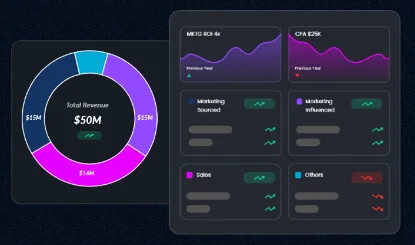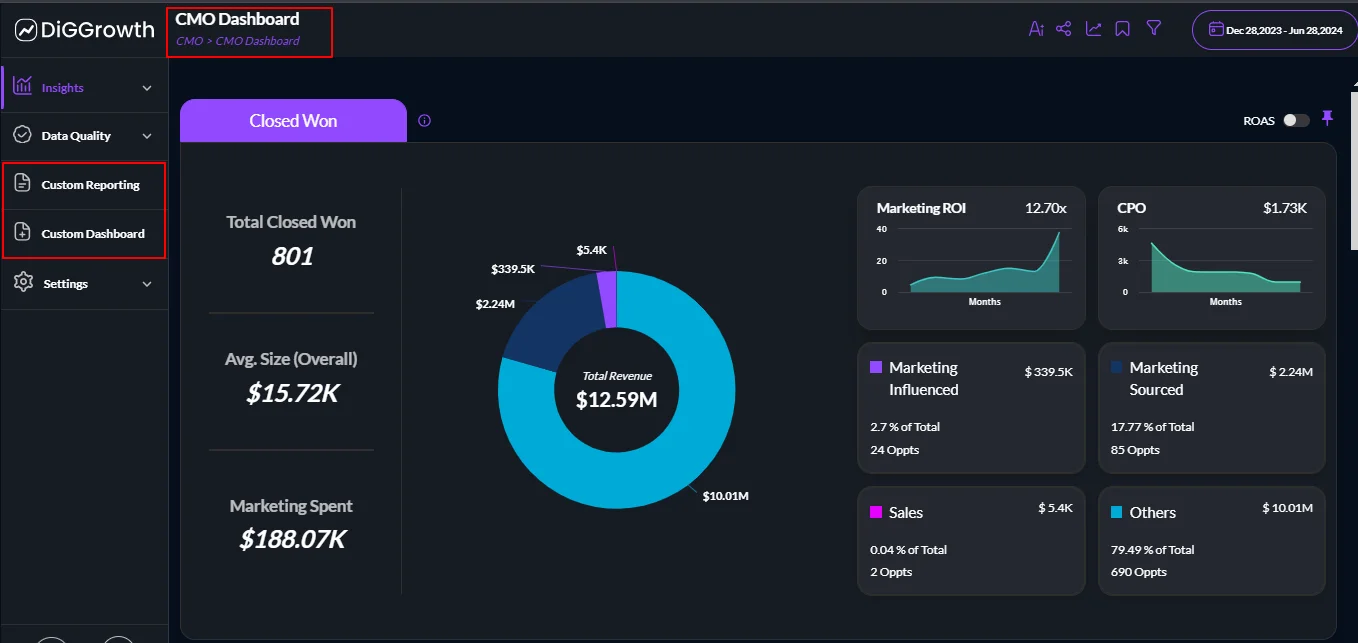
CMO Dashboard Examples
Companies leverage CMO dashboards examples to streamline data analysis and optimize marketing performance. Learn from real-world examples and discover best practices for leveraging key metrics such as ROI and customer lifetime value to drive strategic decision-making and achieve measurable growth in your marketing efforts.
Imagine you are the Chief Marketing Officer, steering a multi-million dollar campaign across a vast digital landscape. You’re bombarded with data, reports, and metrics, all promising insights into your marketing effectiveness. Yet, the big picture needs to be clearer.
Here’s the truth: data is power, but untamed data is chaos. That’s where the CMO dashboard swoops in, transforming scattered information into a crystal-clear roadmap. It’s your personalized GPS in the ever-evolving marketing world, guiding you toward success.
Intrigued? Read on to discover how a CMO dashboard can become your secret weapon for making data-driven decisions, optimizing campaigns, and, ultimately, driving marketing performance.
Key Metrics and Your Marketing Compass: Navigating Performance
The deluge of data in today’s marketing landscape can be overwhelming. Effective decision-making requires a clear understanding of what truly matters. The CMO dashboard is your strategic compass, guiding you toward the essential metrics illuminating your marketing performance.
These metrics act as critical benchmarks, providing a comprehensive picture of your progress and pinpointing areas for optimization. Here are some of the core categories that form the foundation of a well-constructed CMO dashboard:
- Brand Awareness:
- Lead Generation:
- Customer Acquisition:
- Marketing ROI (Return on Investment):
- Campaign Performance:
Measuring audience reach is paramount. Track website traffic, social media mentions, and search volume to gauge the effectiveness of your efforts in building brand visibility.
Attracting qualified leads is the lifeblood of any marketing strategy. Monitor qualified leads, conversion rates, and cost per lead to assess the efficacy of your lead generation initiatives.
The ultimate goal is to convert leads into loyal customers. Monitor customer acquisition cost and lifetime value to understand the profitability and sustainability of your customer base.
Maximizing the return on marketing expenditures is essential. Track marketing ROI to ensure your campaigns generate a positive and sustainable financial impact.
Evaluating the effectiveness of individual campaigns is crucial for optimization. Analyze clicks, conversions, and cost per click for a granular view of each campaign’s performance.
Example: A Deep Dive into Data-Driven CMO Dashboards
In dynamic marketing, Chief Marketing Officers (CMOs) require a real-time window into campaign performance and customer behavior. CMO dashboards are customizable command centers that transform complex data into actionable insights.
E-commerce: Unveiling the Customer Journey with Data Visualization
E-commerce CMO dashboards excel at visualizing key customer journey metrics, providing a comprehensive understanding of purchase behavior. These include:
- Conversion Rate:
- Average Order Value (AOV):
- Customer Retention Rate:
This crucial metric measures the percentage of visitors who complete a purchase.
This metric tracks the average amount spent per transaction. Analyze variations based on product categories, promotions, or customer segments for deeper insights.
This metric monitors the effectiveness of retention strategies. Identify at-risk customers and personalize retargeting campaigns to win them back.
Interactive Dashboards for Strategic Action
Beyond static numbers, these dashboards come alive with interactive features, allowing for deeper exploration:
- Interactive Line Graphs:
- Segmented Funnel Charts:
Compare conversion rates year-over-year or across different marketing channels to identify trends and optimize strategies.
Pinpoint exactly where visitors are dropping off in the purchase journey. Are they abandoning carts or hesitating at checkout? Identify friction points and optimize the user experience for a smoother flow.
DiGGrowth: Powering a Unified Customer View

DiGGrowth goes beyond basic data aggregation. It seamlessly integrates your CRM, website analytics, and marketing automation platforms, painting a complete picture of the customer journey. This holistic approach empowers you to:
- Identify Underperforming Channels:
- Boost Average Order Value:
- Personalize Retargeting Campaigns:
Analyze data to pinpoint traffic sources that aren’t delivering and optimize marketing spend towards high-performing channels.
To increase order value, implement targeted product bundling or upsell recommendations based on customer behavior.
Re-engage abandoning customers with relevant product suggestions or special offers, increasing the likelihood of purchase completion.
SaaS: Optimizing the Subscription Lifecycle for Growth
For SaaS companies, customer retention is paramount. Their CMO dashboards focus on metrics critical to subscription success:
- Monthly Recurring Revenue (MRR):
- Customer Lifetime Value (CLTV):
- Churn Rate:
This metric tracks predictable revenue from subscriptions. Analyze growth rate to identify scaling opportunities.
This metric measures a customer’s total revenue over their relationship with the company.
This metric monitors the percentage of customers canceling subscriptions. Analyze churn by reason (e.g., lack of feature usage, pricing dissatisfaction) to develop targeted solutions.
Actionable Insights Through Visualization
- Stacked Bar Charts:
- Cohort Analysis:
Visually compare MRR growth alongside churn trends to pinpoint improvement areas and growth opportunities.
Segment customers by acquisition timeframe and analyze churn patterns across cohorts. This helps predict future churn risk and allows for proactive intervention.
DiGGrowth: Predictive Analytics for Informed Decisions
DiGGrowth’s advanced analytics go beyond basic reporting, providing predictive capabilities:
- Understand Customer Behavior:
- Optimize Customer Acquisition:
- Increase Customer Engagement:
Identify factors leading to churn and predict churn risk. Develop personalized communication and retention programs for high-risk segments to increase customer satisfaction.
Analyze customer lifetime value to target high-value customers and optimize marketing spend for lower Customer Acquisition Cost (CAC).
Leverage insights to implement features and services that drive user satisfaction and extend CLTV, leading to sustainable growth.
B2B Marketing: Aligning for Revenue Growth Through Data-Driven Insights
B2B marketing success hinges on a strong partnership between marketing and sales. Their CMO dashboards focus on aligning efforts for maximum impact:
- Marketing Qualified Leads (MQLs) vs. Sales Qualified Leads (SQLs) Conversion Rate:
- Pipeline Velocity:
- Marketing-Sourced Revenue:
This metric tracks the effectiveness of turning marketing leads into qualified sales opportunities. Analyze this data to identify areas for improvement in lead nurturing or qualification criteria.
This metric measures the average time it takes leads to progress through each sales stage. Identify bottlenecks and optimize lead nurturing campaigns for faster sales cycles.
This metric quantifies the direct revenue generated by marketing efforts. Demonstrate the true value of marketing to stakeholders and secure further investment in marketing initiatives.
Visualizing the Sales Pipeline for Improved Efficiency
- Waterfall Charts:
- Gauge Charts:
These charts highlight lead drop-off points across the marketing and sales funnel. Identify where leads are lost and address gaps to improve lead qualification and sales efficiency.
These charts display pipeline health and velocity changes over time, helping you track progress towards sales goals.
Best Practices for Designing Effective CMO Dashboards
Creating an effective CMO dashboard involves more than just compiling data; it requires thoughtful design to ensure it delivers actionable insights. Here are some best practices for designing dashboards that empower CMOs to make informed decisions.
Clarity and Simplicity
- Focus on Readability:
- Consistent Design:
- Highlight Key Metrics:
Use charts and graphs that are straightforward to interpret. Avoid overly complex visualizations that may confuse or overwhelm users.
The dashboard should be designed using a uniform color scheme and design language to ensure visual consistency and ease of navigation.
Use visual cues like bold fonts, colors, and placement to highlight the most critical metrics and insights.
Avoiding Data Overload
- Prioritize Information:
- Use Drill-Down Features:
Include only the most relevant data points that provide meaningful insights. Avoid cluttering the dashboard with excessive metrics that do not contribute to decision-making.
Implement drill-down options allowing users to explore data in greater detail, without overwhelming the primary view with too much information.
Alignment with Business Goals
Choosing Metrics that Directly Impact Business Outcomes
- Strategic Relevance:
- Actionable Insights:
Select KPIs that align with the company’s strategic objectives, such as revenue growth, customer acquisition, retention, and brand awareness.
Ensure the chosen metrics can drive actionable decisions. Metrics should help identify opportunities, highlight improvement areas, and track marketing initiatives’ effectiveness.
Regular Review and Adjustment of Dashboard Metrics
- Dynamic Updates:
- Feedback Loop:
Regularly update the dashboard to reflect the latest data and trends, ensuring it remains relevant and useful.
Gather feedback from users to continuously improve the dashboard. Adjust metrics and visualizations based on user input and evolving business needs.
Accessibility and Collaboration
Ensuring the Dashboard is Accessible to All Stakeholders
- User-Friendly Interface:
- Multi-Device Compatibility:
Design the dashboard with an intuitive interface that all stakeholders can easily navigate, regardless of their technical expertise.
Ensure the dashboard is accessible on various devices, including desktops, tablets, and smartphones, to facilitate real-time access and decision-making.
Encouraging Collaboration and Discussion Based on Dashboard Insights
- Shared Access:
- Discussion Features:
Provide access to the dashboard for all relevant team members, fostering a collaborative environment where everyone is informed and aligned.
Incorporate features that allow users to comment and discuss insights directly within the dashboard. This promotes collaborative analysis and collective decision-making.
Pro Tip- Create a wireframe or mockup of your CMO dashboard to experiment with different layouts and ensure key metrics are prominently displayed. Involve key stakeholders early in the design process to gather valuable feedback, promote buy-in, and ensure the dashboard meets everyone’s needs.
Tools and Software for Creating CMO Dashboards
Several platforms stand out for equipping marketing heads with powerful tools for data-driven decision-making, including industry-leading solutions and specialized offerings.
- Power BI:
- Tableau:
- Google Data Studio:
Renowned for its data integration capabilities and customizable dashboards. CMOs can consolidate data from diverse sources, enabling real-time insights and comprehensive reporting.
Ideal for visual storytelling and interactive dashboards. Tableau allows CMOs to effortlessly dissect complex datasets, enhancing decision-making through clear visualizations.
Offers seamless integration with Google’s suite of tools and simplifies dashboard creation. CMOs can generate dynamic reports and efficiently share insights across teams with user-friendly visualizations.
DiGGrowth: A Specialized Solution for Marketing Leaders
DiGGrowth simplifies marketing analytics without requiring technical expertise. It caters specifically to the needs of CMOs by offering:

- Custom Dashboards & Reports:
- ML-Driven Insights:
- No-code Setup:
- Unified Data View:
- Enhanced Data Quality:
- Seamless Data Integration:
- Marketing Analytics:
Tailored to showcase marketing effectiveness and ROI with clarity and precision.
Utilizes machine learning for accurate attribution, conversion tracking, and lead behavior prediction.
Enables quick deployment and ease of use, minimizing IT involvement.
Integrates data from various platforms (e.g., LinkedIn, Facebook, Salesforce) into a single source of truth for informed decision-making.
Supports strategic marketing decisions through comprehensive campaign tracking and data completeness.
Plug-and-play connectors ensure effortless integration across multiple platforms for comprehensive marketing analytics.
Provides detailed insights through custom dashboards and reports specifically designed to meet the needs of marketing heads.
Key Features to Consider
- Customization:
- Real-time Data Updates:
- Integration Capabilities:
Tailor dashboards to highlight critical metrics and KPIs essential for your business and demonstrate marketing ROI.
Ensure insights reflect the latest data for agile decision-making.
Integrate data from various platforms (CRM, marketing automation, social media) to provide a unified and comprehensive view of marketing performance.
Optimizing Your CMO Dashboard for Continuous Improvement
A well-constructed CMO dashboard serves as a cornerstone for data-driven marketing leadership. However, its effectiveness hinges on ongoing optimization. Here are key strategies to ensure your dashboard remains a dynamic and valuable asset:
Establish a Culture of Continuous Review
Regular reviews are crucial to prevent your CMO dashboard from becoming a repository of stagnant data. Schedule these reviews at a frequency aligned with the pace of your marketing initiatives.
- Fast-Paced Campaigns:
- Long-Term Strategies:
Weekly reviews, such as social media marketing or pay-per-click (PPC) advertising, are essential for campaigns with rapid fluctuations. This enables you to identify trends and make strategic adjustments promptly.
Monthly reviews may suffice for campaigns with a longer-term horizon, such as search engine optimization (SEO) or content marketing. However, consider incorporating supplemental check-ins to monitor critical metrics.
Embrace Iteration and Data-Driven Experimentation
Marketing goals and the broader marketing landscape are constantly evolving. Your CMO dashboard should reflect this dynamism. Foster a culture of experimentation, testing different metrics and visualizations to identify the most effective configuration for your team.
- Evaluate Visualization Options:
- Refine Your Metric Selection:
Charts, graphs, and KPI cards have distinct strengths and weaknesses. Experiment with various combinations to determine which formats best communicate complex data to your audience.
As your marketing objectives shift, re-evaluate the metrics displayed on your dashboard. Are there new metrics that offer deeper insights or outdated ones that no longer serve a purpose? Regularly assess your metric selection to ensure it aligns with current priorities.
Foster Collaboration for Enhanced Insights
Your CMO dashboard shouldn’t be an isolated tool. By involving your marketing team in the creation and review process, you can cultivate a data-driven culture and foster team alignment:
- Shared Ownership:
- Diverse Perspectives:
When team members contribute to the dashboard’s development and ongoing evaluation, they become invested in its success and are more likely to use it actively in their decision-making processes.
Including team members with varied skill sets can help identify previously overlooked insights and provide a more comprehensive understanding of marketing performance.
Building Your CMO Dashboard: A Streamlined Approach
Transform marketing data into actionable insights with a well-designed CMO dashboard. Here’s a roadmap to guide your construction process:
- Define Strategic Goals:
- Prioritize Actionable Metrics:
- Choose Your User-Friendly Tool:
- Ease of Use:
- Data Integration Capabilities:
- Visualization Options:
- Streamline Data Integration:
- Identify Data Sources:
- Explore Integration Options:
- Address Data Inconsistencies:
- Design Compelling Visualizations:
- Clarity Reigns Supreme:
- Leverage Visual Hierarchy:
- Context is Key:
- Schedule Reviews and Embrace Iteration:
Your marketing objectives are the foundation. Clearly define your goals, whether they’re amplifying brand awareness, maximizing customer lifetime value, or measuring ROI. These goals will guide the selection of relevant metrics.
Focus on a manageable set of metrics directly tied to your goals. Prioritize metrics that influence marketing decisions and provide a clear picture of progress. Resist information overload; quality over quantity is key.
The market offers a variety of intuitive CMO dashboarding tools. Evaluate factors like:
The platform should be user-friendly, allowing easy customization even for non-technical users.
For a holistic view, ensure seamless data integration from your existing marketing platforms (CRM, website analytics).
To communicate complex data effectively, choose a tool with various visualization options (charts, graphs, KPI cards).
Unifying your marketing data requires integrating various sources. Here’s how:
List all your marketing platforms (e.g., CRM, social media platforms).
Most dashboarding tools offer built-in connectors or utilize APIs for seamless connection to your platforms.
Be prepared to address potential inconsistencies (e.g., different naming conventions) to ensure accurate data reflection on your dashboard.
Data visualization is key for clear communication. Prioritize clarity with these practices:
Ensure visualizations are clear, concise, and easy to understand for all viewers.
Use color, size, and position to guide viewers’ attention to the most important information.
Always provide context for your visualizations, including labels, legends, and timeframes.
Your CMO dashboard is a living document. Schedule regular reviews to assess progress toward your goals and identify areas for improvement. Be prepared to iterate and refine metrics, visualizations, and the overall layout based on new insights and evolving marketing strategies.
Key Takeaways
- CMO dashboards transform scattered marketing data into actionable insights, guiding data-driven decisions and campaign optimization.
- Effective dashboards focus on key metrics aligned with strategic goals, like brand awareness, lead generation, customer acquisition, marketing ROI, and individual campaign performance.
- Interactive features like line graphs, segmented funnels, and stacked bar charts enable deeper exploration and identification of trends and improvement areas.
Conclusion
CMO dashboards are essential tools for navigating the complex landscape of modern marketing. By providing a clear view of key metrics and performance indicators, these dashboards empower CMOs to make data-driven decisions that drive growth and efficiency. In e-commerce, SaaS, or B2B marketing, leveraging a well-designed dashboard can transform data into a powerful strategic asset.
Ready to supercharge your marketing performance with a customized CMO dashboard?
Contact info@diggrowth.com to learn how DiGGrowth can help you turn data into actionable insights and drive your marketing success.
Ready to get started?
Increase your marketing ROI by 30% with custom dashboards & reports that present a clear picture of marketing effectiveness
Start Free Trial
Experience Premium Marketing Analytics At Budget-Friendly Pricing.

Learn how you can accurately measure return on marketing investment.
Additional Resources
Don’t Let AI Break Your Brand: What Every CMO Should Know
AI isn’t just another marketing tool. It’s changing...
Read full post postFrom Demos to Deployment: Why MCP Is the Foundation of Agentic AI
A quiet revolution is unfolding in AI. And...
Read full post postAnswer Engine Optimization (AEO): The New Frontier of SEO in 2025
As digital experiences continue to evolve, so does...
Read full post postFAQ's
It's best to update your CMO dashboard regularly, ideally in real-time or daily, to ensure the data reflects current performance. For long-term strategies, weekly or monthly reviews can suffice but should be supplemented with frequent check-ins for critical metrics.
Yes, most CMO dashboards can integrate data from various sources, such as CRM systems, social media platforms, and marketing automation tools. This provides a unified view of your marketing performance and helps you make holistic, data-driven decisions.
To keep your dashboard relevant and effective, continuously gather feedback from users and stakeholders, regularly review and adjust metrics based on evolving business goals, and stay updated with the latest industry trends and tools.
Avoid cluttering the dashboard with too many metrics, using overly complex visualizations, neglecting alignment with business goals, and failing to ensure accessibility for all stakeholders. Keeping the design simple and focused on actionable insights is key.
Promote a data-driven culture by involving team members in creating the dashboard, providing training on interpreting the data, and integrating dashboard insights into regular meetings and decision-making processes to encourage consistent use.
 Shagun Sharma
Shagun Sharma  Sameer Pawar
Sameer Pawar 

